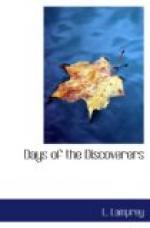Ojeda was, in fact, spoiling for adventure, and joyfully set sail in the direction of the Carib Islands. Seven coast natives were on board as guides, and pointed out the island inhabited by their especial enemies. The shore was lined with fierce-faced savages, painted and feathered, armed with bows and arrows, lances and darts and bucklers. Ojeda launched his boats, in each of which was a paterero, or small cannon, with a number of soldiers crouching down out of sight. The armor of the Spaniards protected them from the Indian arrows, while the cotton armor of the savages and their light shields were no defense against cannon-balls or crossbow-bolts.
When the barbarians leaped into the sea and attacked the boats the cannon scattered them, but they rallied and fought more fiercely on land. The Spaniards won that day’s battle, but the dauntless islanders were ready to renew the fight next morning. With his fifty-seven men Ojeda routed the whole fighting force of the tribe, made many prisoners, plundered and set fire to the villages, and returned to his ships. A part of the spoil was bestowed on the seven friendly natives. Ojeda, who had not received so much as a scratch, anchored in a bay for three weeks to let his wounded recover. There were twenty-one wounded and one Spaniard had been killed.
Sailing westward along the coast the fleet presently entered a vast gulf like an inland sea, on the eastern side of which was a most curious village. Ojeda could hardly believe the evidence of his own eyes. Twenty large cone-shaped houses were built on piles driven into the bottom of the lake, which in that part was clear and shallow. Each house had its drawbridge, and communicated with its neighbors and with the shore by means of canoes gliding along the water-ways between the piles. The interpreters said it was called Coquibacoa.
“That is no proper name for so marvelous a place,” said Ojeda after he had tried to pronounce the clucking many-syllabled word. “Is it like anything you have seen, Vespucci?”
The Italian had been comparing it with a similar village he had seen on his first voyage, on a part of the coast called Lariab. He had an instinct, however, that it would not be well to mix his own discoveries with those of the present expedition.
“It is rather like Venice,” he said demurely.
“That is the name for it,” cried Ojeda in high delight,—“Venezuela—Little Venice!”
“It would be interesting,” observed Vespucci, “to know what names they are giving to us. How they stare!”
The people of the village on stilts were evidently as much astonished at the strangers as the strangers were at them. They fled into their houses and raised the draw-bridges. The men in a squadron of canoes which came paddling in from the sea were also terrified. But this did not last long. The warriors went into the forest and returned with sixteen young girls, four of whom they brought to




